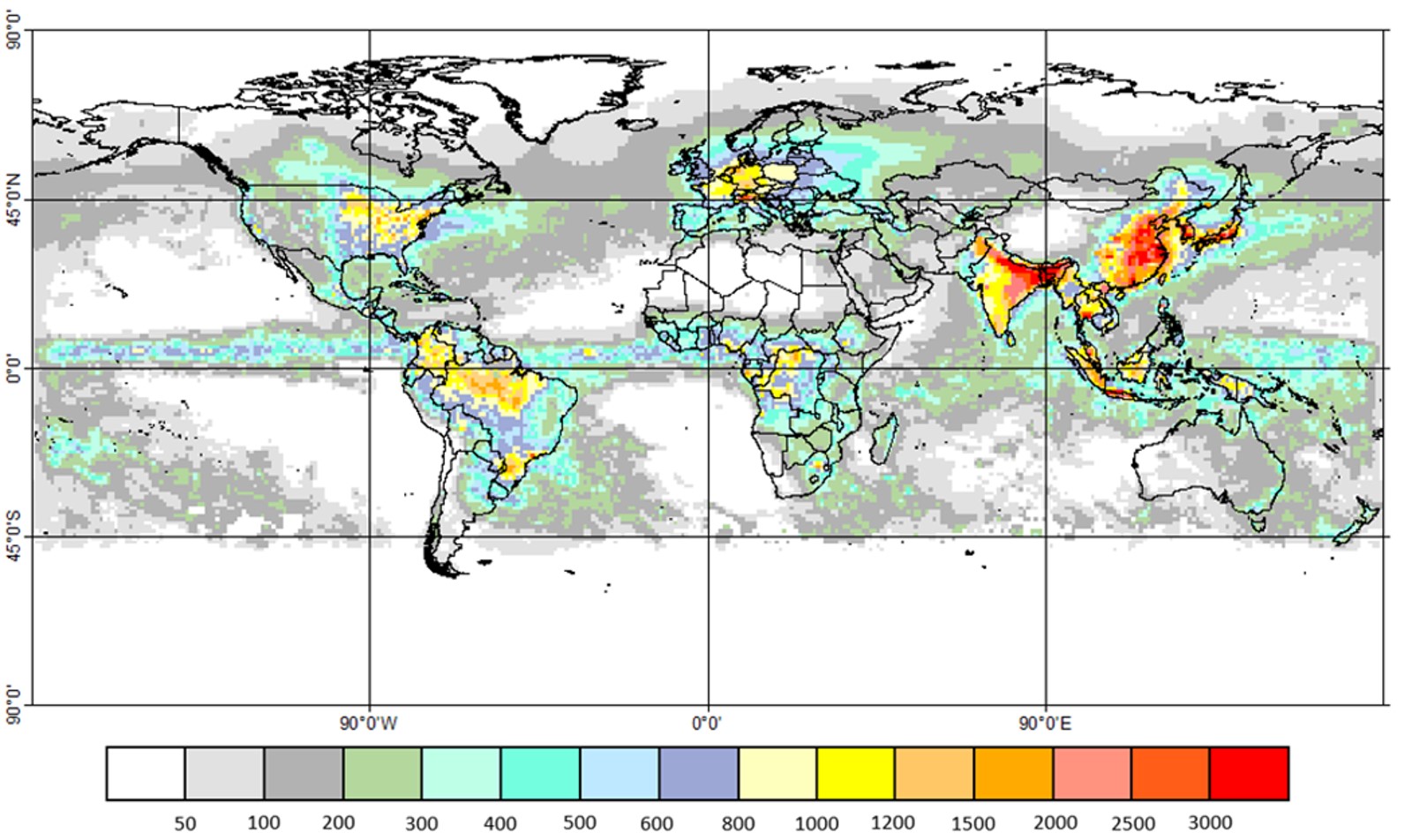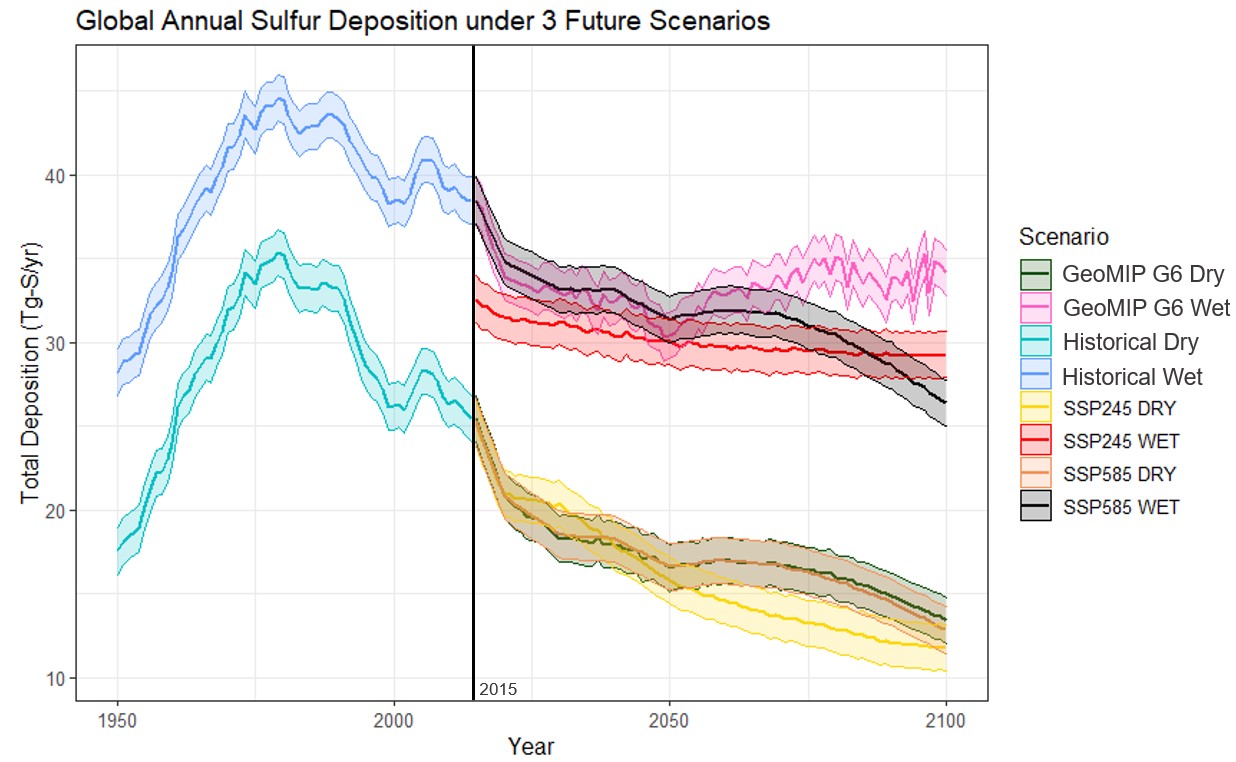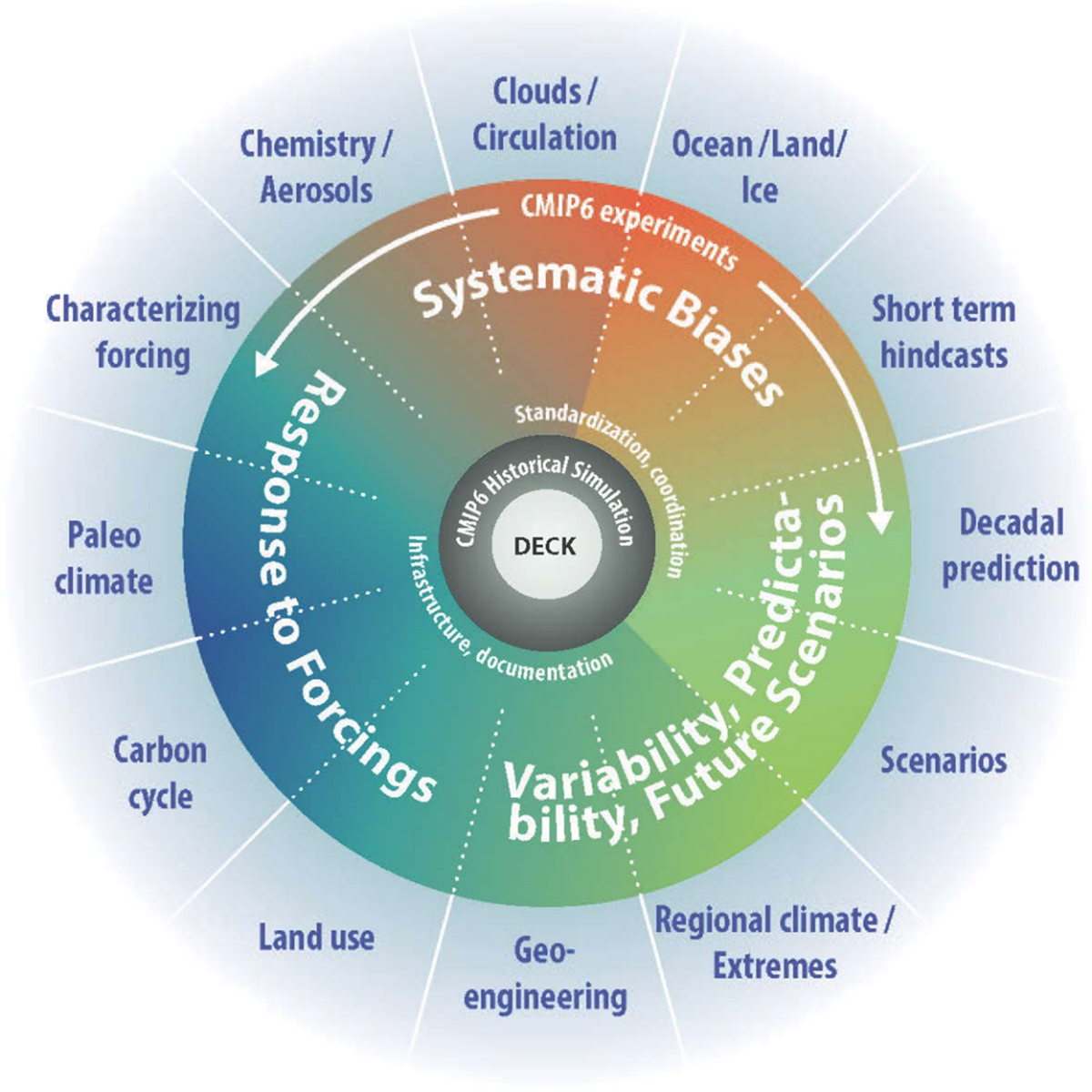Air Quality

Global reactive nitrogen (N) deposition has more than tripled since 1860 and is expected to remain high due to land use changes and fossil fuel consumption. We are updating the 2010 global deposition budget for nitrogen and sulfur with new regional wet deposition measurements from Asia, improving the ensemble results of eleven global chemistry transport models from the second phase of the United Nation’s Task Force on Hemispheric Transport of Air Pollution (HTAP-II). Our work demonstrates that a global measurement-model fusion approach can substantially improve N and S deposition model estimates at a regional scale and represents a step forward toward the World Meteorological Organization’s goal of global fusion products for accurately mapping harmful air pollution.
Ozone in China
Ozone formation is driven by two emitted precursors: nitrogen oxides and volatile organic compounds. This nonlinear relationship and the complex photochemical reactions involved make it challenging to model and predict ozone levels. Machine learning and measurement-model fusion are two approaches that can help. Our work in China improves model estimates.
Non-methane volatile organic compounds (NMVOCs) are primary precursors for the formation of ozone and secondary organic aerosol which contribute to increased public health risks. Evaporative NMVOC emissions increase and associated air quality impacts are exacerbated during periods of high temperature such as heatwaves. Adoption of strict evaporative emission standards and controls such as onboard refueling vapor recovery systems (ORVR) can significantly reduce evaporative emissions during such events; however, emissions inventories used to inform policy decisions are developed using average temperature profiles which fail to capture the impact of heatwave events on evaporative emissions. Our work evaluates the effectiveness of the previous generation (Euro5), current (Euro6d), and proposed (Euro7) emission control standards on evaporative emissions at high temporal and spatial resolution in western and central Europe.
Utilizing sustainable aviation fuel from biomass feedstock is a major avenue to meet carbon reduction targets. It is important to have a well-designed life cycle analysis for the fuel supply chain. To make an adequate estimate of soil organic carbon (SOC) in the life cycle analysis, a systematic approach that integrates spatial and temporal variations and continuity is important. Most current soil carbon, properties, flux, and storage databases are not spatially or temporally continuous. We aim to improve soil organic carbon estimates and investigate long-term trends in the US using in-situ measurements from soil carbon networks and previous studies and incoporate satellite remote sensing and machine learning methods for more complete spatial and temporal coverage.
Extreme Events
Wildfires emit smoke particles and gaseous pollutants that greatly aggravate air quality and cause adverse health impacts in the western US. We evaluates how wildfire impacts on air pollutants and air toxics evolve from the present climate to the future climate under a high anthropogenic emission scenario at regional and city scales.
Heat Waves and Drought

It is well accepted that heat waves are increasing in frequency, intensity, and duration due to climate change; however, predictions of the region-specific risks from heat waves remain limited. We are working on a systematic investigation of heat waves and drought in the US at a regional scale from 2020-2059 under the high-emissions climate scenario SSP5-8.5 using two separate ensembles of six dynamically and statistically downscaled Coupled Model Intercomparison Project Phase 6 (CMIP6) models.
Geoengineering
Wildfires
Wildfires have become serious environmental and societal issues, causing great property losses and endangering human lives and ecosystems. Multiple climate intervention strategies have been proposed to offset further warming brought on by elevated anthropogenic emissions, which induce a higher potential for adverse environmental impacts including fires. However, as vegetation productivity increases due to CO2 fertilization in a cooler climate created through solar radiation management, biomass that serves as available fuel load increases in an intervened climate, causing a more severe burning activity once fires occur. We investigate how fire activities evolve from the past to the future climate both at global and ecoregional scales.
Sulfur Deposition

The widespread harmful impacts to humans and ecosystems are being felt worldwide and current pledges to reduce emissions are not adequate to even maintain warming at 2 degrees C above historical temperatures. In addition to reducing emissions and adapting to a warmer climate, climate intervention may be needed to slow warming. Decreasing radiative forcing does not address the fundamental issue of too much carbon dioxide in the atmosphere, but it would give the world more time to reduce and stabilize emissions. One method of altering the atmosphere’s radiative budget is stratospheric aerosol injection. However, when sulfur dioxide is injected into the lower stratosphere, some of it will be deposited back onto land and marine environments. Therefore, we are evaluating the spatial and temporal patterns of sulfur deposition and its potential impacts on human and ecosystem health.
Arctic Black Carbon

iStockphoto.com/PytyCzech
The U.S. Department of Energy's efforts in support of the Arctic Black Carbon Initiative (ABCI) sought to minimize BC emissions from existing equipment in countries that impact the Arctic environment. To accomplish this the following objectives were pursued:
Identify the location of BC emissions sources to enable strategic deployment of emissions control technologies to the sources; Improve estimates of BC emissions in the regions surrounding the Arctic with an emphasis on District Heating and Cooling (DHC) and Combined Heat and Power (CHP) sources by working with a range of researchers and stakeholders to fill in the gaps of the existing available emissions inventory, and perform data assurance and quality control; Assess BC emissions reduction opportunities at district heating, power generation and/or industrial sites in Russia and encourage the adopt ion of highly-efficient, low-emissions CHP and DHC systems through a demonstration project and targeted educational outreach. Due to a series of international events culminating in the June 2014 annexation of the Crimean Peninsula from the Ukraine, the DOE project changed course with respect to the third objective and focused more effort on outreach.
Models and Data

Eyring et al. 2016
HTAP II The Task Force on Hemispheric Transport of Air Pollution (TF HTAP) is an international scientific cooperative effort to improve the understanding of the intercontinental transport of air pollution across the Northern Hemisphere.
CESM The Community Earth System Model (CESM version 2.0) is a state-of-the-art model used for the global climate simulation, including four major components: atmosphere, land, ocean, and sea ice. It is maintained by the Climate and Global Dynamics Laboratory at the National Center for Atmospheric Research (NCAR)
CMIP6 The Coupled Model Intercomparison Project Phase 6 is a project of the World Climate Research Program (WCRP)’s Working Group of Coupled Modeling (WGCM) that coordinates climate model experiments worldwide, using common protocols, climate forcings, and output formats to provide future climate predictions.
CMAQ The Community Multiscale Air Quality Monitoring System is an open-source project lead by the US EPA that consists of multiple air quality models to estimate ozone, particulates, toxins, and acid deposition.
WRF The Weather Resarch and Forecasting Model is a mesoscale numerical weather prediction system for atmospheric research, run by the Natioanl Center for Atmospheric Research (NCAR)'s Mesoscale & Microscale Meteorology Laboratory.
HPC High-performance computing allows us to run models and perform analyses on very large datasets. We work with Oak Ridge Leadership Computing Facility (OLCF), National Energy Research Scientific Computing Center (NERSC), and UTK resources.
ABACAS The Air Benefit and Cost and Attainment Assessment System (ABaCAS)is being developed by an elite team of "Sino-US" scientists aimed at providing policy makers and scientists in China with a user-friendly system framework for conducting integrated assessments of emissions control cost and their associated air quality attainment and health benefits.